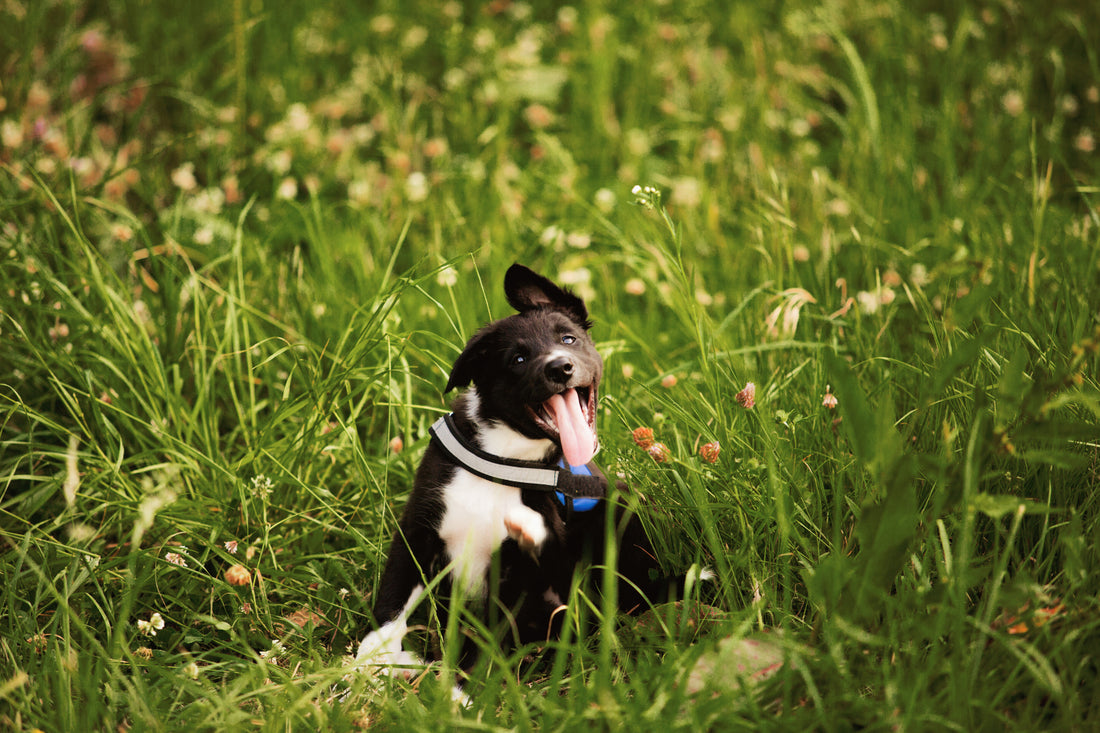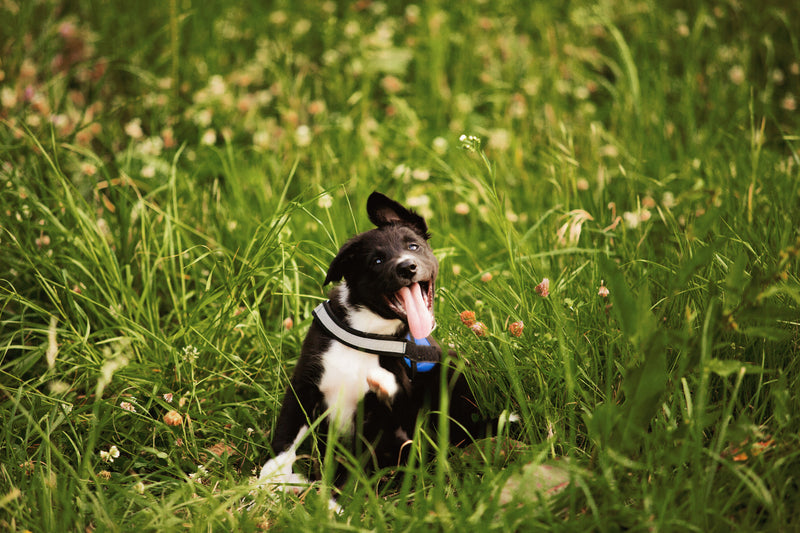All dogs will scratch behind their ears every so often. Occasional scratching and minor bouts of itchiness are perfectly normal. However, if scratching and even licking seem obsessive, they might be having a serious problem. Incessant scratching, licking, whimpering, and panting are all signs that your dog might have more than just a passing itch.
While itchy skin itself might not be a major issue for your dog, if left unaddressed it could easily evolve into open wounds from obsessive scratching, infections from obsessive licking, sleepless nights, miserable days, and an expensive vet visit. Better to avoid the situation altogether with some simple, over-the-counter solutions
There are a few things you can try or buy to help soothe your dog's itchy skin issue. Some of these suggestions are time-tested techniques you can do using everyday items from your pantry, others are extremely effective products that are basically itchy skin relief in a bottle. Barring any major, underlying issues, you should find a solution for your pup below!
Soothe your dog’s itchy skin at home
You may have everything you need to help your pooch with their itchy skin at home! While none of these suggestions are medical-grade treatments and likely to work on only the less severe cases, they’re still worth a try.
Colloidal Oatmeal Bath
Oatmeal is naturally anti-inflammatory and can often soothe a dog’s itchy skin. This is an especially helpful thing to try if your dog is itchy all over, rather than just in a single area. Soaking them for about 10 minutes in an oatmeal bath, and massaging the solution into their skin, will provide relief and protection from persistent (yet relatively minor) itchy skin.
Note: If you think the itch is caused by yeast, you should avoid using oatmeal baths or shampoos. The sugar and starch in these products will feed the yeast, making the itch worse.
Apple Cider Vinegar
If the itch is being caused by an external factor like poison oak or external yeast infection, a 50/50 mixture of apple cider vinegar and water may provide the relief you're looking for. You can use a spray bottle to spritz the solution directly on the itchy spots. Also, if you suspect an internal yeast infection to be the primary cause of the itch, you can feed your dog 1/4 to 1/2 teaspoon of the mixture twice per day with food. Or simply mix a teaspoon of apple cider vinegar into your dog's water (this may be a more palatable option). This should begin the process of making your dog’s digestive system an inhospitable environment for yeast.
Coconut Oil
Naturally derived, virgin coconut oil is antimicrobial, antiviral, antibacterial, and antiprotozoal. You can feed from ¼ of a teaspoon up to ½ of a teaspoon once to twice per day and you can massage some of the oil into your dog’s skin to provide some immediate itch relief.
Baking Soda
You can use a thick paste consisting of 50/50 water and baking soda to alleviate the discomfort and underlying conditions causing your dog’s itchy skin. You can treat your dog’s skin directly for roughly 20 minutes per day. After 20 minutes, be sure to rinse the paste off completely.

Products that soothe your dog’s itchy skin
Sometimes you need a little ready-made itch-stopping solution that contains some special ingredients you don’t have access to at home. This is where a store-bought topical solution comes in. Here are some common options.
Anti-itch and skin-soothing shampoos
Did you know that a healthy cleaning routine is important to keeping your dog’s skin itch-free? Bathe your dog too little, and contamination or infections may build up on their skin causing the itch; bathe too much, and you strip the healthy oils away that protect their skin from drying out or becoming irritated. A quick rinse whenever needed, and a wash every 6 weeks or so (unless your dog gets something on their coat they shouldn’t ingest) is a great rule of paw for clean and healthy skin.
Now, if your dog’s skin is already itchy, giving them a bath using a specially formulated anti-itch shampoo is a good idea. You can try a detergent free option like our Probiotic Anti-itch shampoo, Zymox shampoo containing their LP3 Enzyme System and vitamin D3, Tropiclean Hypoallergenic shampoo made with all-natural ingredients, Vet's Best Itch Relief shampoo for a vet formulated solution, or Septiderm-V Antiseptic Skin Care Bath to help fight against any bacterial skin infection that may be causing the itch
Itch Relief Spray
If the itchy area is more localized, an itch relief spray may be appropriate. These sprays promote healthy skin by providing relief from itching caused by inflammation, dermatitis, and skin irritations. You could try our Kahoots Wound Care Spray which contains chitosan, a natural active ingredient that provides immediate itch relief while promoting healing of irritations and providing anti-bacterial anti-fungal treatments while creating a protective barrier over the itchy area. Pretty cool, huh?
Other great options include a Zymox Topical Spray with LP3 Enzyme, aloe vera, and hydrocortisone. Sentry Anti-Itch Spray is vet-formulated to soothe skin irritations and provide itch relief.
Their itchy skin may be diet-related
Dogs can develop itchy and dry skin from a diet that isn’t quite right for them. Many dog foods have low-quality ingredients like animal by-products or are overly stuffed with damaging ingredients like corn. Over time, these ingredients create infections and nutritional imbalances that can result in extremely itchy skin. If you’ve tried topical treatments and nothing has worked, you may be dealing with itchy skin thanks to a low-quality diet.
If you suspect that your dog’s diet could be the cause of their itchy skin, it’s time to make a change. Here’s how.
1. Avoid damaging ingredients
Take a look at the ingredients on the label of whatever food you’re thinking about feeding. If you see corn, soy, vegetable oil, animal byproduct, or any ingredients with “gluten”, “animal” or “meat” in its name, don’t feed this formula to your dog. Your goal should be to avoid filler ingredients as well as those that cause inflammation or cause symptoms of food intolerance.
2. Ensure high-quality meats are the primary ingredient.
Your dog should definitely be eating lots of high-quality meat. The closer to raw the protein, the more biologically available and healthier for your dog. On the ingredient list of any food, a named meat protein (e.g. beef), a named meat meal (e.g. beef meal), or both should be listed first, before any grain or vegetable. Biologically appropriate foods like these (foods that the dog's body is designed to digest) increase digestibility and nutrient absorption, reducing inflammation and diet-related dysfunction.
3. Supplement with probiotics and Omega-rich oils
To improve skin health, it is equally important to supplement a high-quality diet with high-quality probiotics and healthy, omega-rich oils. Good probiotics will help your dog process their food as efficiently as possible and simplify the transition to a new food, if necessary! Healthy oils, like salmon or hemp seed oil, give your dog the cellular building blocks they need to regenerate, hydrate, and heal their skin.
When to go to a vet
If their skin is still itchy after trying the at-home remedies, store-bought solutions, and a change in diet, you may be dealing with a more serious situation than some simple skin irritation. If your dog’s symptoms are from an allergic reaction, fungal infection, or bacterial infection, you may need to take them to the vet for diagnosis and treatment.
Look out for persistent digestive upset including vomiting and runny stools, open sores or lesions in the skin, excessive panting and other signs of pain, lethargy, excessive head shaking, obsessive licking, and chewing at the paws. These could be signs that you should take your dog to see a vet as soon as possible.
Disclaimer: we are not vets. We simply care about your animals as much as our own and do our research to make the best suggestions we can. If you’re concerned for your dog's health, the best thing to do is take them to a vet.


